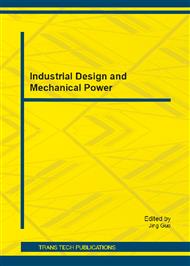[1]
J.H. Dautzenberg, The Minimum Energy Principle for the Cutting Process in Theory and Experiments. Annals of the CIRP, Vol. 32, No. 1, pp.223-227, (1983).
Google Scholar
[2]
J. Jurko-M. Džupon-A. Panda-M. Gajdoš-I. Pandová, Deformation of Material Under the Machined Surface in the Manufacture of Drilling Holes in Austenitic Stainless Steel. Chemické listy, Vol. 105, (S), pp.600-602, ISSN 0009-2770, (2011).
Google Scholar
[3]
J. Jurko-A. Panda-M. Gajdoš, Study of changes under the machined surface and accompanying phenomena in the cutting zone during drilling of stainless steels with low carbon content. Metalurgia journal, Vol. 50, 2, pp.113-117, ISSN 0543-5846, (2011).
DOI: 10.1109/icacte.2010.5579026
Google Scholar
[4]
M. Džupon-M. Gajdoš-J. Jurko-M. Ferdinandy-D. Jakubeczyová, Plastic Deformation Around Holes Drilled in Austenitic Steel 1. 4301. Chemické listy, Vol. 105, (S), pp.606-608, ISSN 0009-2770, (2011).
Google Scholar
[5]
J. Jurko-A. Panda-M. Gajdoš, Accompanying phenomena in the cutting zone machinability during turning of stainless steels. International Journal Machining and Machinability of Materials, INDERSCENCE Publisher, Vol. 5, No. 4, 2009, 383-400 p. ISSN 1748-5711, (2009).
DOI: 10.1504/ijmmm.2009.026899
Google Scholar
[6]
S. Adamczak-W. Makiela et al., Statistical validation of the method for measuring radius variations of components on the machine tool In: Metrology and Measuring Systems Vol. 18, no. 1, pp.35-46, ISSN: 0860-8229, (2011).
DOI: 10.2478/v10178-011-0004-5
Google Scholar
[7]
J. Murčinko–Z. Murčinková–M. Štiavnický, Structure Analysis of Mould Parts Made of Materials for Soft Moulds. In: Proceedings in Manufacturing Systems, Vol. 4, pp.327-330, ISSN1842-3183, (2009).
Google Scholar
[8]
J. Gašparová-J. Šugárová-D. Kalincová, Study of microstructure and formed part wall thicness changes after metal spinning. In Development of mechanical engineering as a tool for the enterprise logistics progress : science report : project CII-PL-0033-01-0506, Poznan University of Technology, ISBN 83-89873-28-1, pp.187-192, (2006).
Google Scholar
[9]
W. Makiela-J. Zajac, An evaluation of irregularities of milled surfaces by the wavelet analysis, ICAEEI, Venice, Italy, September 7-10, 2010, pp.63-69, ISBN 978-80-553-0519-6, (2010).
Google Scholar
[10]
A. Vagaská, Štatistické modelovanie riadenia kvality obrábaného povrchu. Statistical quality control modeling of cutting surface. In: Acta Mechanica Slovaca. Roč. 12, č. 1-A/2008, pp.325-330. ISSN 1335-2393, (2008).
Google Scholar
[11]
W. Liew-B. Ngoi-Y. Lu, Wear characteristics of PCBN tools in the ultra-precision machining of stainless steel at low speeds. Wear, Vol. 254, No. 3-4, pp.265-277, (2003).
DOI: 10.1016/s0043-1648(03)00002-4
Google Scholar
[12]
A. Czán, Intenzifikácia tvrdého sústruženia s povlakovanými keramickými reznými materiálmi. In: Strojírenská technológie-obrábení. Ostrava, VŠB-TU, pp.1-8, ISBN 80-248-0895-1, (2005).
Google Scholar
[13]
Nam,P. Suh, New Theories of Wear and Their Implications for Tool Materials. Wear, 62, pp.1-20, (1980).
DOI: 10.1016/0043-1648(80)90033-2
Google Scholar
[14]
D. Peckner I.M. Bernstein, Handbook of Stainless Steels. New York: McGraw-Hill, (1977).
Google Scholar
[15]
G. Poulachon-A. Moisan I.S. Jawahir, Tool-wear mechanisms in hard turning with polycrystalline cubic boron nitride tools. Wear, Vol. 250, No. 1-12, pp.576-586, (2001).
DOI: 10.1016/s0043-1648(01)00609-3
Google Scholar


